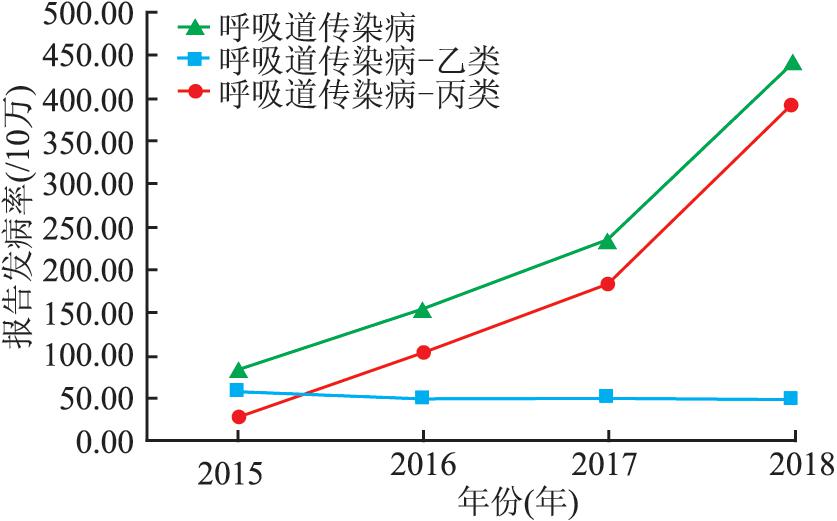Epidemiological characteristics of notifiable respiratory infectious diseases in Beijing from 2015 to 2018
-
摘要:
目的 了解北京市2015-2018年法定呼吸道传染病的发病及流行特征, 为呼吸道传染病防控提供依据。 方法 采用描述性流行病学方法分析北京市2015-2018年法定呼吸道传染病发病监测报告数据, 描述其发病的主要特征。 结果 2015-2018年北京市法定呼吸道传染病年均报告发病率227.64/10万, 占法定传染病总报告的36.24%。乙、丙类呼吸道传染病分别呈现下降、上升趋势。6种重点传染病流行趋势和好发人群各不相同。 结论 2015-2018年因流行性感冒大幅上升导致北京市法定呼吸道传染病发病率升高, 防控责任重大。每种不同的呼吸道传染病的流行季节、好发人群等特征不同, 需针对不同病种之间不同的流行特征采取不同的防控措施。 Abstract:Objective To explore the epidemiological characteristics of notifiable respiratory infectious diseases in Beijing from 2015 to 2018. Methods Descriptive epidemiological method was used to analyze the monitoring data of notifiable respiratory infectious diseases, and to describe the main characteristics of the diseases. Results Average annual reported incidence was 227.64/100 000, accounting for 36.24% of the total reports and deaths of notifiable infectious diseases. Class B and C respiratory infectious diseases showed a downward and upward trend respectively. The epidemic trend and risk population of the six major infectious diseases were different. Conclusions The incidence and mortality of legal respiratory infectious diseases in Beijing increases year by year due to the sharp increase of influenza from 2015 to 2018, and the responsibility of prevention and control is great. Respiratory infectious diseases have different epidemic season and predisposing population. Different prevention and control measures should be taken according to the different epidemic characteristics of different diseases. -
Key words:
- Notifiable respiratory infectious diseases /
- Surveillance /
- Incidence
-
表 1 北京市2015-2018年法定呼吸道传染病报告发病情况[n(%/100 000)]
Table 1. The reported incidence of notifiable respiratory infectious diseases in Beijing from 2015 to 2018[n(%/100 000)]
分类及病种 2015年 2016年 2017年 2018年 年均值 总计 18 001(83.66) 33 258(153.23) 50 568(232.72) 95 436(439.66) 49 316(227.64) 乙类合计 12 160(56.52) 10 691(49.26) 10 953(50.41) 10 529(48.51) 11 083(51.16) 丙类合计 5 841(27.15) 22 567(103.97) 39 615(182.31) 84 907(391.15) 38 233(176.48) 单病种 麻疹 1 322(6.14) 1 247(5.75) 64(0.29) 103(0.47) 684(3.16) 肺结核 6 879(31.97) 6 731(31.01) 7 114(32.74) 6 606(30.43) 6 833(31.54) 流脑 4(0.02) 0(0.00) 3(0.01) 6(0.03) 3(0.02) 百日咳 93(0.43) 91(0.42) 116(0.53) 188(0.87) 122(0.56) 猩红热 3 861(17.94) 2 621(12.08) 3 643(16.77) 3 626(16.70) 3 438(15.87) 人感染H7N9禽流感 1(0.00) 1(0.00) 13(0.06) 0(0.00) 4(0.02) 流行性感冒 3 439(15.98) 20 279(93.43) 37 439(172.30) 82 887(381.84) 36 011(166.22) 流行性腮腺炎 2 157(10.03) 2 172(10.01) 2 125(9.78) 1 962(9.04) 2 104(9.71) 风疹 245(1.14) 115(0.53) 51(0.23) 58(0.27) 117(0.54) 麻风病 0(0.00) 1(0.00) 0(0.00) 0(0.00) 0(0.00) -
[1] 中华人民共和国国家卫生健康委员会.中华人民共和国传染病防治法[EB/OL]. (2018-08-30)[2019-05-30]. http://www.nhc.gov.cn/fzs/s3576/201808/58d2b24710c14c2f97ae6de5a8059b73.shtml.National Health Commission of the People's Republic of China.Law on the infectious diseases prevention and control of The Peo-ple's Republic of China[EB/OL].(2018-08-30)[2019-05-30]. http://www.nhc.gov.cn/fzs/s3576/201808/58d2b24710c14c2f97ae6de5a8059b73.shtml. [2] 中华人民共和国国家卫生和计划生育委员会.国家卫生和计划生育委员会关于调整部分法定传染病病种管理工作的通知[EB/OL]. (2013-10-28)[2019-05-30]. http://www.nhc.gov.cn/jkj/s3577/201311/f6ee56b5508a4295a8d552ca5f0f5edd.shtml.National Health and Family Planning Commission of the People's Republic of China.Notice of the People's Republic of China na-tional health and family planning commission on adjusting the part of notifiable infectious diseases management[EB/OL].(2018-08-30)[2019-05-30]. http://www.nhc.gov.cn/jkj/s3577/201311/f6ee56b5508a4295a8d552ca5f0f5edd.shtml. [3] 天津医学院流行病学教研室.常见呼吸道传染病的防治[M].天津: 天津人民出版社, 1974.Department of Epidemiology, Tianjin Medical College. Prevention and treatment of common respiratory infectious diseases[M]. Tianjin: Tianjin People's Publishing House, 1974. [4] 王丽萍, 曾令佳, 任翔, 等.中国2013年报告法定传染病发病及死亡特征分析[J].中华流行病学杂志, 2015, 36(3): 194-198. DOI: 10.3760/cma.j.issn.0254-6450.2015.03.002.Wang LP, Zeng LJ, Ren X, et al. Analysis of morbidity and mortality characteristics of the notifiable diseases reported in 2013 in China[J]. Chin J Epidemiol, 2015, 36(3): 194-198. DOI: 10.3760/cma.j.issn.0254-6450.2015.03.002. [5] 陈涛, 杨静, 汪立杰, 等. 2016-2017年度中国大陆流行性感冒监测分析[J].中国人畜共患病学报, 2018, 34(3): 193-199. DOI: 10.3969/j.issn.1002-2694.2018.00.036.Chen T, Yang J, Wang LJ, et al. Surveillance analysis of influenza in Mainland China during 2016-2017 season[J]. Chinese Journal of Zoonoses, 2018, 34(3): 193-199. DOI: 10.3969/j.issn.1002-2694.2018.00.036. [6] 于孟轲, 谢铮, 严述瑞, 等.北京市提高流感疫苗接种率的经验分析[J].中华实用儿科临床杂志, 2019, 34(2): 116-119. DOI: 10.3760/cma.j.issn.2095-428X.2019.02.008.Yu MK, Xie Z, Yan SR, et al. Empirical analysis on improving influenza vaccination rate in Beijing[J]. Chin J Appl Clin Pediatr, 2019, 34(2): 116-119. DOI: 10.3760/cma.j.issn.2095-428X.2019.02.008. [7] Peasah SK, Azziz-Baumgartner E, Breese J, et al. Influenza cost and cost-effectiveness studies globally: a review[J]. Vaccine, 2013, 31(46): 5339-5348. DOI: 10.1016/j.vaccine.2013.09.013. [8] Ting EEK, Sander B, Ungar WJ. Systematic review of the cost-effectiveness of influenza immunization programs[J]. Vaccine, 2017, 35(15): 1828-1843. DOI: 10.1016/j.vaccine.2017.02.044. [9] 黄晨阳, 周雨晴, 傅晓芳, 等.四价流感疫苗:应用进展与展望[J].中华临床感染病杂志, 2019, 12(1): 73-80. DOI: 10.3760/cma.j.issn.1674-2397.2019.01.013.Huang CY, Zhou YQ, Fu XF, et al. Progress and prospects of quadrivalent influenza vaccine[J]. Chin J Clin Infect Dis, 2019, 12(1): 73-80. DOI: 10.3760/cma.j.issn.1674-2397.2019.01.013. [10] 许雷, 张嘉陵, 谷利妞, 等. 2008-2017年连云港市麻疹流行病学特征及免疫水平监测分析[J].现代预防医学, 2019, 46(7): 1295-1297.Xu L, Zhang JL, Gu LN, et al. Epidemiological characteristics and immune level of measles in Lianyungang from 2008 to 2017.[J]. Modern Preventive Medicine, 2019, 46(7): 1295-1297. [11] 史芸萍, 李刚. 2015年北京市法定传染病流行特征分析[J].首都公共卫生, 2016, 10(2): 63-66. DOI: 10.16760/j.cnki.sdggws.2016.02.005.Shi YP, Li G. Epidemiological characteristics of notifiable diseases in Beijing, 2015[J]. Capital Journal of Public Health, 2016, 10(2): 63-66. DOI: 10.16760/j.cnki.sdggws.2016.02.005. [12] 王连森, 王凤田, 丁淑军, 等.山东省手足口病疫情报告周末效应分析[J].中华疾病预防控制杂志, 2015, 19(2): 142-144. DOI: 10.16462/j.cnki.zhjbkz.2015.02.010.Wang LS, Wang FT, Ding SJ, et al. The weekend effect of hand-foot-mouth disease reported in Shandong Province[J]. Chin J Dis Control Prev, 2015, 19(2): 142-144. DOI: 10.16462/j.cnki.zhjbkz.2015.02.010. [13] 孙婕, 杨雯雯, 曾令佳, 等. 2011-2016年全国6-22岁学生人群法定传染病监测数据分析[J].中华流行病学杂志, 2018, 39(12): 1589-1595. DOI: 10.3760/cma.j.issn.0254-6450.2018.12.010.Sun J, Yang WW, Zeng LJ, et al. Surveillance data on notifiable infectious diseases among students aged 6-22 years in China, 2011-2016[J]. Chin J Epidemiol, 2018, 39(12): 1589-1595. DOI: 10.3760/cma.j.issn.0254-6450.2018.12.010. [14] 宣国, 俞丹丹, 张玲玲, 等.上海市金山区2011-2016年中小学生传染病发病状况[J].中国学校卫生, 2018, 39(9): 154-156. DOI: 10.16835/j.cnki.1000-9817.2018.09.045.Xuan G, Yu DD, Zhang LL, et al. Prevalence of infectious diseases among primary and secondary school students in Jinshan District, Shanghai, 2011-2016[J]. Chin J Sch Health, 2018, 39(9): 154-156. DOI: 10.16835/j.cnki.1000-9817.2018.09.045. [15] 王瑜, 史芸萍, 李刚.北京2012-2015学年大中小学生乙类传染病流行特征分析[J].中国公共卫生, 2017, 12: 1724-1726. DOI: 10.11847/zgggws2017-33-12-13.Wang Y, Shi YP, Li G. Prevalence characteristics of category B infectious diseases among students in Beijing, 2012-2015[J]. Chin J Public Health, 2017, 12: 1724-1726. DOI: 10.11847/zgggws2017-33-12-13. [16] 徐文婕, 白承续, 花晨曦, 等.北京市2010-2017学年学生法定及重点监测传染病发病情况[J].中国学校卫生, 2019, 40(7): 1061-1064. DOI: 10.16835/j.cnki.1000-9817.2019.07.028.Xu WJ, Bai CX, Hua CX, et al. Prevalence of infectious diseases in schools in Beijing in 2010-2017 academic years[J]. Chin J Sch Health, 2019, 40(7): 1061-1064. DOI: 10.16835/j.cnki.1000-9817.2019.07.028. -





 下载:
下载:



